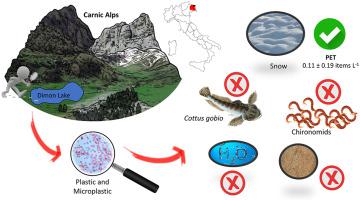Chemosphere ( IF 8.1 ) Pub Date : 2020-11-26 , DOI: 10.1016/j.chemosphere.2020.129121 Paolo Pastorino , Elisabetta Pizzul , Marco Bertoli , Serena Anselmi , Manuel Kušće , Vasco Menconi , Marino Prearo , Monia Renzi

|
Plastic pollution has become a pervasive environmental problem on a global scale, from the ocean depths to the aquatic ecosystems of the Tibetan Plateau. To date, data on plastic and microplastic occurrence in pristine ecosystems like high-mountain lakes are lacking. In this study, plastic (>5000 μm) and microplastic (10-5000 μm) levels were measured in snow at the end of the winter season (April 2020), and in water, sediment, and biological samples collected monthly (June – October 2019) during the ice-free season from the Dimon Lake, a high-mountain lake in the Carnic Alps, northeast Italy. Biological samples consisted of chironomids (Diptera, Chironomidae; n=150) and stomach contents of Cottus gobio (n=40). Analysis of the water, sediment, and biological samples revealed the absence of plastic and microplastics larger than 10 μm, whereas the snow samples contained microplastics of polyethylene terephthalate (PET) albeit at very low levels (0.11 ± 0.19 L-1). These results show that while the lake ecosystem could be considered unpolluted by microplastics, abundant snow precipitation in winter can trap microplastic particles that deposit on the ground. The very low levels of PET microparticles recorded in the snow samples suggest the need for further research to better understand the source of microplastic pollution in this environmental matrix.
中文翻译:

对生物区隔和非生物区隔中的塑料和微塑性发生以及高山湖泊积雪(Carnic Alps)的初步见解
从海洋深处到青藏高原的水生生态系统,塑料污染已成为全球范围内普遍存在的环境问题。迄今为止,缺乏有关原始生态系统(如高山湖泊)中塑性和微塑性发生的数据。在这项研究中,在冬季(2020年4月)结束时在雪中以及在每月(6月至10月)收集的水,沉积物和生物样品中测量了塑料(> 5000μm)和微塑料(10-5000μm)的水平。 2019)在意大利东北部卡恩阿尔卑斯山的高山湖泊Dimon湖的无冰季节。生物样品由尺ron(双翅目,尺ron科; n = 150)和胃线虫的胃内容物组成(n = 40)。对水,沉积物和生物样品的分析显示,没有大于10μm的塑料和微塑料,而降雪样品中的聚对苯二甲酸乙二醇酯(PET)的微塑料含量很低(0.11±0.19 L -1)。这些结果表明,虽然可以认为湖泊生态系统未受到微塑料的污染,但冬季大量的降雪可以捕获沉积在地面上的微塑料颗粒。雪样中记录的PET微粒含量极低,表明需要进一步研究以更好地了解这种环境基质中的微塑性污染源。









































 京公网安备 11010802027423号
京公网安备 11010802027423号